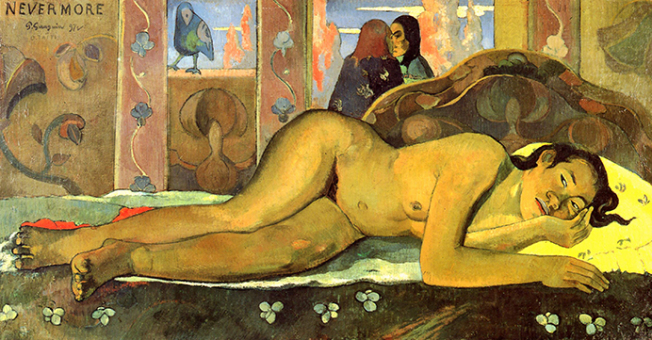
Here is a powerful nude by Paul Gauguin. You may recall he was the guy who went off to the South Seas in the late 1800s to live, and paint the dream. Turns out it was not so much the dream people thought is was…
Gauguin’s island paintings are fascinating images, sometimes containing apparent symbols and hints of a mysterious island life. The paintings have a kind of primitive aura, or project the primitive aura people back in Paris found interesting anyway. There’s a lot to the Gauguin story: some romantic, some not so much.
• What, When, Who, Where:
Nevermore (1897)
by Paul Gauguin
French painter. Painted in Tahiti.
Image Source: Wikimedia Commons
• What’s Cool About It:
This is a mysterious, almost chilling painting. It’s not what I’d describe as a “feel good” painting, but it is moving, and visually striking. This is what I love about art… there’s so much to think about here. It’s full of swirls and colors and interesting motifs (like repeating flowers). And of course a beautiful Tahitian woman. But, what really gets to us here, I think, are these curious elements:
- The title: Nevermore. That’s from an Edgar Allen Poe poem of the same name. “Quoth the Raven Nevermore,” he says. The poem is about a talking raven’s mysterious visit to a distraught lover, and follows the man’s slow fall into madness. Was this woman driving Gauguin to madness? Gauguin himself says he did not intend to reference the poem.
- The look on her face is far away, disconnected. It appears she is indulging Gauguin, but at the same time, not letting him connect. Perhaps his entire island experience was like that… an outsider.
- Those women in the background… ominous looking, aren’t they? Are they gossiping about her? Do they disapprove?
- The bird on the windowsill. It’s not a raven, but it’s spooky. Gauguin said it was “a bird of the devil.” Creepy enough for me.
• Behind the Scenes:
Gauguin… I think was not the guy to have as your best pal. He was arrogant and egocentric. He started out in Paris as a stockbroker, and was somewhat successful, but decided to chuck it all (including wife and five children, who suffered over time) and be an artist. He was known to drink, carouse, and is thought to have contracted syphilis, from which he may have eventually died. To escape it all he went to the the South Seas, only to find that the islands were much more westernized than he had imagined. He chose to live away from the town with the Tahitian natives. He enjoyed the Tahitian girls and and one point became involved with a 13 year-old.
I doubt I would have liked the man. Which poses an interesting question: If we don’t like the artist, can we like the art? I’ll save that for another post.
• Fun Fact:
Gauguin spent time with Vincent Van Gogh in the south of France – the infamous period where Van Gogh cut off part of his ear. In the (excellent) movie, “Vincent and Theo,” it is put forth that Vincent’s brother Theo paid Gauguin to go spend the time with his brother. I don’t know if this is true or not, but seem plausible. Either way, it appears to have been a toxic relationship that ended poorly for both. It has even been theorized that it was Gauguin that cut off Van Gogh’s ear with a fencing epee he had with him. Seems a tad unlikely to me – a recreational fencing epee is not a sharp instrument. Not enough to dash an ear off anyway.
• Food for Thought:
Can we enjoy a work of art done by someone who we might not like? A man who abuses a 13 year-old (maybe)? A man who cuts and ear off (maybe)? A man who overindulged in absinthe and possible morphine? I start to think no, and even as I get to the end of this post I wonder… do I like this painting?




